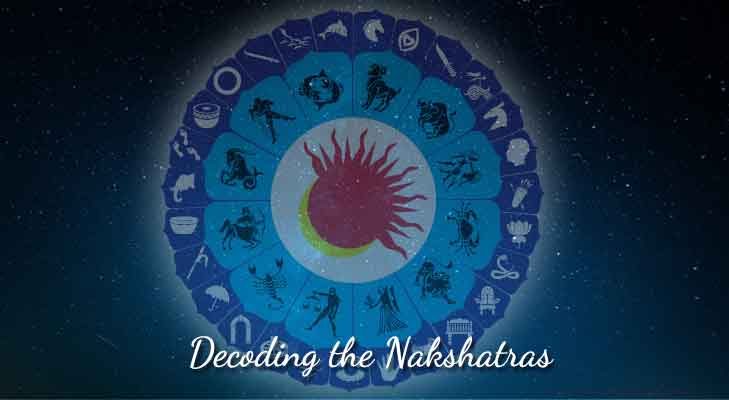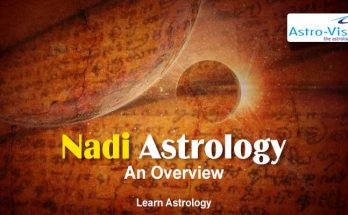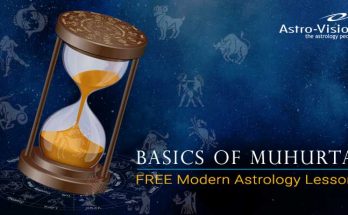Decoding the Nakshatras
Importance:
In all astrological prognostications, the Nakshatras in which planets reside happen to be the most decisive factors for predicting the nature of results and events of the planets. The very term Nakshatra in Sanskrit is derived from the root term which implies “imperishable.” The Nakshatras are 28 in number out of which 27 (except Abhijit) are used for all predictive purposes. The radiation that comes from the Nakshatras is said to be more powerful than the radiation that comes from the signs of the Zodiac. The intrinsic nature of any planet gets altered when it comes to the direct influence of the Nakshatras. Hence, studying the characteristics of the Nakshatras in detail will aid in understanding the invisible vibrations surrounding a planet that is responsible for altering the planet’s basic nature, which in turn creates a direct and inedible impact on the life and psyche of the native of the chart under consideration.
Prediction through Nama Nakshatras – Modern Astrology Updates
On attempting to delineate the qualities of the Nakshatras in a detailed manner, it was found that each one of them has its own diverse influences. These diverse qualities have been practically adopted in predictive astrology by the ancient masters as applicable to human beings. The popular qualities of these Nakshatras are caste, species, temperament, direction, the type of animal, etc., which have been extensively used for the purpose of matching horoscopes to check the compatibility of the couple intending to get married. The lordships assigned to the Nakshatras are commonly used in the predictive part in judging the results of Bhavas or the houses. However, very little has been explored to venture beyond and use the other qualities in the predictive area. An effort is made here to highlight a few of those lesser-known principles for not only ease of understanding but also for enabling their use in practical cases to get better and deeper predictive insights.
Qualities of Nakshatras:
It is seen upon delving deep into esoteric literature, that the basic influence of the Nakshatras are intrinsically dual in nature and their final impact on the individual is either on the evolving side and/or on the materialistic side. Although at the outer level they have diversified connotations like gender, primary impulse, motivating impulse, three levels of Gunas, connotations of their symbolic representation, presiding deities, etc., they work differently in the charts of the individual native based on whether one is on an evolutionary path or is treading a materialistic path. As such, their impact on those going through a materialistic path would obviously be different from those following an evolutionary path. An abstract view of some important qualities of the 27 Nakshatras culled out from esoteric literature is presented in Table I.

Passive and Active Qualities:
The qualities of Nakshatras and their interrelationship with human life can be understood using a 3-pronged approach:
Gender Traits:
The first step is to understand the importance of the correlation between the genders of both the Nakshatras and the planets with the four basic Purushartas of life i.e., Dharma, Artha, Kama, and Moksha. Although the Puranas mention that the Nakshatras are daughters of Prajapati, they are further classified in astrology as male and female.
The female Nakshatras are said to be 14 in number and the male Nakshatras, 13 in number. The female Nakshatras are known to have static energy which is primarily passive in nature and acts as a preservative; whereas, the Nakshatras categorized as male are known to have active qualities which act primarily as generative. Therefore, in order to bear fruit, the static female Nakshatras have to come in contact with an external force, preferably by a male planet for it to get highly charged. If such a combination is present at birth, depending upon the nature of the planet connected with the Nakshatra, the results will start flowing. The female Nakshatras are merely an instrument and the result will be as per its operator. These points can be used as a general rule for interpretation. Also, if the female planets have occupied female Nakshatras unaspected by any of the male planets, then these Nakshatras will get surcharged only when a male planet activates them during transit. Upon correlating the interrelationship with the Nakshatras and the basic Purushartas, one understands that the female Nakshatras are primarily interested in generating Dharma, Kama and Moksha impulses and they are equally divided, 4 each, into each of these Purushartas. Only one Nakshatra, i.e., Punarvasu, alone has motivating impulse as Artha (material gain). Artha as a Purushartha is primarily concerned with excess activity having purposeful motivation. As female Nakshatras are primarily preservative, excess activity and taking initiatives are not their forte and they need external support to be surcharged. This interlink has been shown in Table IIA and Table IIB
Table II A
| Dharma | Artha | Kama | Moksha |
| Everything for the other | Wealth and Power for Self | Pleasure for self | Liberation for self |
Table II B – Female Nakshatras
| Sl.No | Nakshatra | Gender | Motivating Impulse |
| 1 | Krittika | Female | Kama |
| 2 | Rohini | Female | Moksha |
| 3 | Mrigasira | Female | Moksha |
| 4 | Ardra | Female | Kama |
| 5 | Punarvasu | Female | Artha |
| 6 | Pubba | Female | Kama |
| 7 | Hasta | Female | Moksha |
| 8 | Chitta | Female | Kama |
| 9 | Visakha | Female | Dharma |
| 10 | Anuradha | Female | Dharma |
| 11 | Dhanishta | Female | Dharma |
| 12 | Satabisha | Female | Dharma |
| 13 | Uttarabhadra | Female | Kama |
| 14 | Revati | Female | Moksha |
The male Nakshatras are said to make the native highly active and more the planets in these Nakshatras, more active the individual would be and it is said that such natives if pushed by circumstances for inactiveness generally become very depressive. In contrast to female Nakshatras, the majority of the male Nakshatras, 6 of them, have Artha, material gain, as their motivating impulse as the activity is their primary intent while the rest of them get divided into Dharma and Moksha Purushartas equally. The male Nakshatras are also less passionate in comparison to the female Nakshatras as barring from Moola, none of the Nakshatras have Kama (passion) as their motivating impulse. This interlink has been shown in Table III-A and Table III B.
To be contd…
Courtesy: Modern Astrology (Pradeep Y Gowda)
Previous: Nadi Kuta Agreement by Nakshatra Padas









